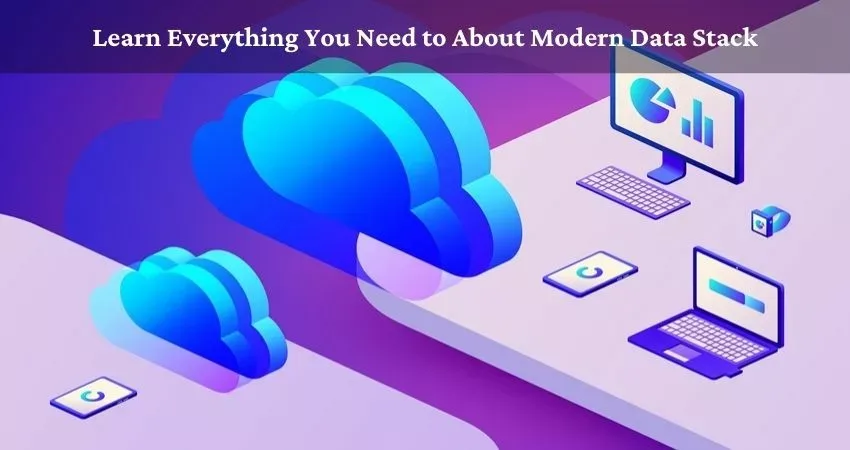Modern data stack is a fairly new approach towards data integration. Moreover, it saves time, which allows engineers, developers, and analysts to work on priority tasks.
Most importantly, data is “the new oil of the digital economy”. Hence it is important to employ a robust data integration process.
Furthermore, it utilizes a suite of tools for data integration. Hence, the tools streamline the process of collecting and combining data from various sources.
Hence, in this article, we will delve deeper into the subject of modern data stacks.
Here is Everything You Need to Learn About Modern Data Stack
What is Modern Data Stack?
A modern data stack is also known as the modern data landscape. As a result, it comprises tools to diminish complexities while arranging and regulating data platforms.
Furthermore, it constantly reduces the unnecessary transfer of meager data sources. As a result, it automates the data sources to a single location using Extract and Load jobs.
That is to say, it aims to analyze data. Hence, it perceptively discovers new opportunities and improves efficiency. As a result, these tools are:
- A completely managed ELT data pipeline,
- A cloud-based columnar warehouse or data lake as a destination,
- A data transformation tool,
- A Business Intelligence or data visualization platform.
Types of Backend Data Sources
- Database: It is a collection of data that is structured and organized. Hence, it is set up to easily access, manage and update.
- Data Warehouses: This is a data storage technique built to unite various sources. Hence, it includes data from different databases, applications, and large data volumes.
- Data Lakes: However, when data volume reaches a high amount and organization is not a hassle, that is when data lake offers to catalog and storing information. Hence, this system is seen when data analysis depends on logs.
How to Build a Modern Data Stack?
A modern data stack comprises of four stages. Therefore, the tools focus on a robust data warehouse on the cloud platform. As a result here are the four pivotal stages:
- Collection: It is the ingestion stage that collects data from various sources. As a result, the data sources include databases, web applications, and APIs.
- Loading: Loading is a process where data is loaded in cloud-based data warehouses.
- Transformation: Transformation tools help eliminate raw data and apply actionable logic.
- Analysis: Therefore, the final stage utilizes data visualization tools. Wherein the tools help generate reports and organize insights using the data.
Modern Data Architecture and its Components
Modern data architecture comprises certain products and tools used to manage data. Moreover, it offers services to capture, transform, and deliver actionable data.
Furthermore, it helps businesses discover consumable data and unique requirements. As a result, it flows from right to left, that is from consumable data to data sources.
Hence, here are the components of Modern Data Architecture:
- Data Pipeline: Data pipeline refers to prebuilt connectors for all data sources. As a result, to quickly set it up for scaling data integration. Therefore, it is completely managed to consider API changes or schema changes.
- Destination: Destination is a process to help scale the computing and storing aspects. However, it avoids lengthy downtime to accommodate data storage and analytics requirements.
- Transformations: A transformation is a tool that is compatible with the destination. Moreover, it offers features to easily track data lineage.
- Business Intelligence and Data Visualization: As a result, technical implementation, visualization flexibility, and user accessibility should be considered. Additionally, criteria like user self-service on tools are dependent on the data structure.
Difference between Modern Data Stack and Legacy Data Stack
Most importantly, a modern data stack works in the cloud. As a result, it requires minimal technical configuration.
Whereas, a legacy data stack uses on-premise systems to process data. Hence legacy data stacks would not be feasible in the near future.
Ultimately, it reduces technical barriers for data entry for integration. Although, legacy data stack is limited when migrating data.
Moreover, modernizing a data platform enables businesses to access deep and actionable insights. Hence, businesses must invest in modern data stacks as a solution over legacy data stacks.
Benefits of Modern Data Stack
- Most importantly, modern data stack uses cloud computing and storage components. Hence, the low and declining costs of cloud systems optimize time, money, and efforts.
- Moreover, it simplifies data sharing from various sources.
- Furthermore, it allows Marketing, Finance, HR, and other teams to access data. Hence, it optimizes the performance and increases efficiency in the business.
- Above all, it offers new and modern techniques for strategies.
- Furthermore, it uses robust cloud platforms, separates storage, and uses elastic scalability. Hence, it automates data integration.
- Moreover, it employs authentic transformation layers. As a result, it transforms raw data into reliable and actionable insights.
- Most importantly, it combines cloud-based data sources with legacy. As a result, it offers solutions for on-premise components for businesses of all sizes and nature.
- Consequently, it also provides professionals with key business insights. Hence, offering them support for important decision-making and strategy-building tasks.
Conclusion:
Hence, a modern data stack is faster in connecting data. Most importantly, it processes data in a warehouse to analyze using a common set of tools.
A modern data stack is a cloud-based solution. As a result, it reduces the cost of hiring more engineers by using the right tools.
You May Also Like To Read:
Top 9 Infrastructure Automation Tools
Top 12 Open Source Log Analysis Tools
The Best Data Orchestration Tools that Businesses should be aware of


Add Comment